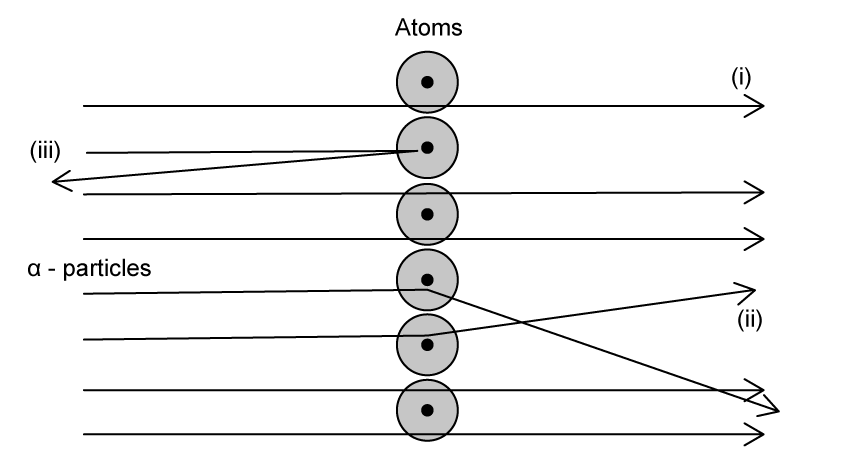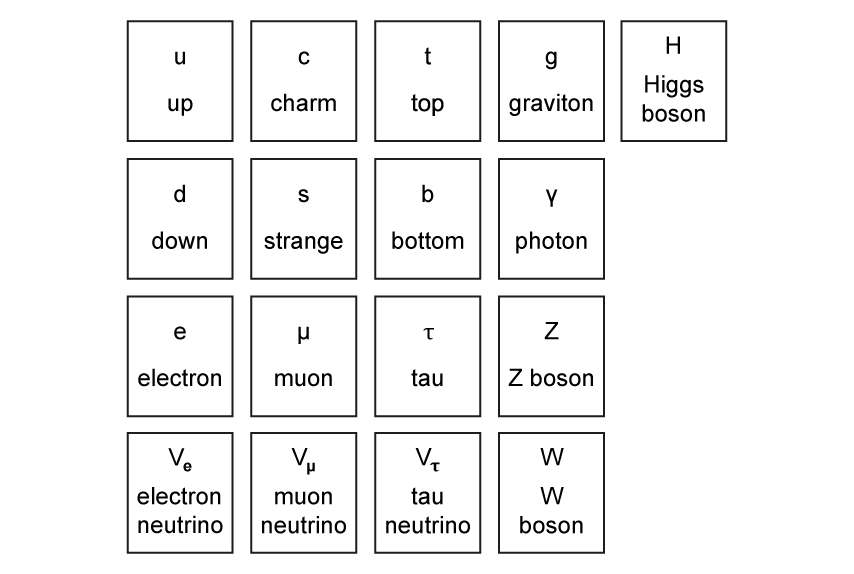The Rutherford-Geiger-Marsden Experiment provided evidence for the structure of the atom. The set up consisted of alpha particles being fired at a thin gold foil, with a detector to detect deflected particles.
The diagram shows some of the potential paths taken by the alpha particles.
(a)
Draw lines to connect the correct statements for each path of the alpha particle.
[3]
Assess your score
View Answer
Since Rutherford's discovery, further discoveries about the nature of matter have been made.
(b)
Complete the following sentences with appropriate words or phrases:
The nucleus is made of ________ and ________, and these themselves are made of the fundamental particles known as ________. Any particle made of these is known as a ________. Another example of a fundamental particle is the ________.
[5]
Assess your score
View Answer
One type of hadron is the K+ meson, which has a strangeness of +1.
(c)
(i)
State the quark composition of a meson
[1]
(ii)
State the baryon number of a K+ meson
[1]
(iii)
Show that the quark composition of a K+ meson is
[4]
Assess your score
View Answer
Electrons are an example of another type of fundamental particle called a lepton.
(d)
(i)
State the charge on a muon.
[1]
(ii)
State the mass of the electron neutrino.
[1]
(iii)
State the fundamental force which leptons do not interact with, but quarks do.
[1]
Assess your score
View Answer
Next Question
The following particles are available:
(a)
Identify all examples of:
(i)
Hadrons.
[1]
(ii)
Leptons.
[1]
(iii)
Antiparticles.
[1]
(iv)
Charged particles.
[1]
(v)
Exchange particles.
[1]
Assess your score
View Answer
Quarks can combine to give various baryons and mesons. The proton and neutron are the baryons which subsequently make up the nucleus.
(b)
State the quark composition of:
(i)
A proton.
[1]
(ii)
A neutron.
[1]
Assess your score
View Answer
The proton has a charge of +1e .
(c)
Explain why the proton has this charge by referring to the charge of its constituent quarks.
[2]
Assess your score
View Answer
Protons and neutrons are both examples of baryons. An electron is an example of a lepton
(d)
Complete the table below with the correct charge, baryon and lepton numbers for each particle.
Assess your score
View Answer
Previous Question Next Question
The four fundamental forces are mediated through exchange particles.
(a)
Define the phrase 'exchange particle'.
[2]
Assess your score
View Answer
(b)
Draw lines to match the force with the correct exchange particle:
[4]
Assess your score
View Answer
(c)
Arrange the four fundamental forces in the boxes below the arrow in order of strongest to weakest.
[3]
Assess your score
View Answer
Feynman diagrams represent particle interactions in the form of a diagram.
The following is a Feynman diagram showing beta−minus decay, with the exchange particle missing.
(d)
Label the correct exchange particle on the diagram.
[1]
Assess your score
View Answer
Previous Question Next Question
(a)
State what is meant by the standard model of particle physics.
[2]
Assess your score
View Answer
The standard model describes the fundamental particles that make up other sub-atomic particles.
One method of representing the standard model is as shown in the diagram below.
(b)
Complete the missing information in the boxes in the diagram.
[3]
Assess your score
View Answer
Another more detailed way of showing the standard model is shown below, where the different fundamental particles are arranged on cards:
(c)
By writing a letter in the correct box, identify:
(i)
Quarks, with the letter Q
[1]
(ii)
Leptons, with the letter L
[1]
(iii)
Gauge bosons, with the letter B
[1]
Assess your score
View Answer
The final particle on the standard model diagram in part (b) is the Higgs boson. It was predicted in 1964 and confirmed in 2012.
(d)
State what the Higgs boson is responsible for.
[1]
Assess your score
View Answer
Previous Question Next Question
The following Feynman diagram shows a particle interaction.
(a)
Label the axes of the Feynman diagram.
[2]
Assess your score
View Answer
(b)
State:
(i)
The exchange particle in the interaction shown in part (a).
[1]
(ii)
The fundamental force represented by this exchange particle.
[1]
Assess your score
View Answer
The Feynman diagram in part (a) represents part of the particle interaction
The composition of each particle in terms of quarks is:
(c)
(i)
Identify the two particles in this interaction which contain a strange or anti-strange quark .
[2]
(ii)
By considering the strangeness of each of the particles, show that strangeness is conserved in this interaction.
[3]
(iii)
State the interaction which does not conserve strangeness.
[1]
Assess your score
View Answer
Quarks can only exist within hadrons, this is known as quark confinement.
(d)
Complete the gaps in the sentences below to describe confinement:
There are two types of hadron, ________ and ________. Quarks cannot be ________ but must be in pairs or triplets. Quarks are kept in place by ________. If an attempt is made to separate quarks, more ________ are produced using the energy required to separate them.
[5]
Assess your score
View Answer
Previous Question







